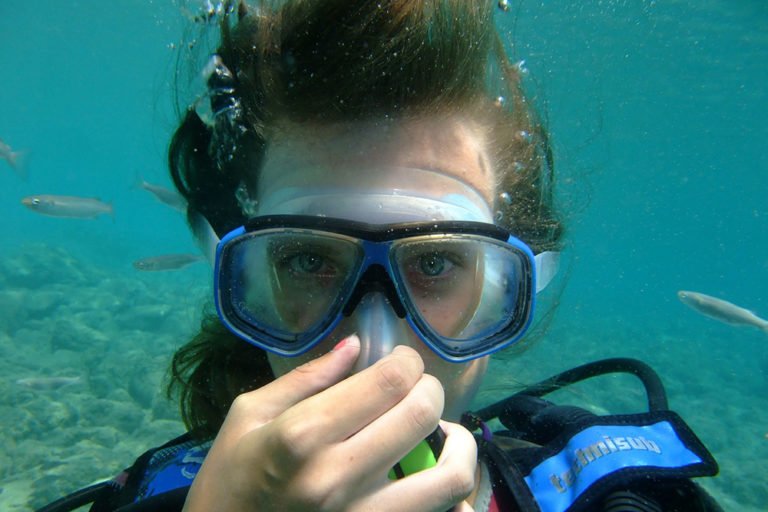How to Equalize Your Ears While Scuba Diving

We’ve all experienced that sharp, throbbing pain in our ears when we dive too deep in a swimming pool. But, there’s easy ways to avoid inner ear pain when scuba diving by equalizing your ears before and during your dive.
A QUICK ANATOMY LESSON
Our ears are made up of three main areas called the outer, middle, and inner. The middle ear is closed off from the outer world by eustachian tubes, which connect the ears to the throat. These tubes maintain the balance between the outer and inner ear pressure when pressure changes occur in the surrounding air or water.
When you don’t increase the pressure in your middle ears to match the pressure in the outer and inner areas, you can severely damage your ears. The most common condition is called ear barotrauma, which causes pain and discomfort at varying degrees.
Symptoms of mild ear barotrauma:
- pain in the ear
- difficulty hearing or mild hearing loss
- dizziness
- a feeling of fullness and pressure in the ear
Symptoms of moderate to severe ear barotrauma:
- damage to the eardrum
- bleeding from the ear
- increased pain in the ear
- constant feeling of pressure and fullness in the ear, as if underwater
- moderate to severe hearing loss
When you swallow you naturally equalize the pressure between the sections of your ears. Go ahead, try swallowing. You’ll hear a soft “click” or “pop” – that’s your soft palate muscles pulling open your eustachian tubes. As these tubes open, higher-pressure air rushes from your throat to your middle ear. This equalizes the pressure and prevents inner ear damage as the pressure of your surroundings change.
PRESSURE UNDERWATER
When you go diving, the water pressure increases rapidly the deeper you go. At one foot below the surface, the water pressure is 0.445 psi more than on the surface. While at 10ft, the pressure difference is 4.45 psi. If you don’t equalize and descend slowly, your eardrums can break from this increased pressure and water will flood your middle ear. To avoid this, it’s crucial that you open your eustachian tubes early and often, so air can enter and equalize the pressure.
IT’S NEVER TOO EARLY TO START EQUALIZING YOUR EARS
And when we say early, we mean it. A few hours before you dive, practice equalizing your ears every few minutes. You can even chew gum beforehand as it naturally forces you to swallow more often. Be sure to swallow right before you enter the water – you should hear that soft “pop” or “click” to let you know that your eustachian tubes are open and ready for your dive.
TIPS FOR EQUALIZING UNDERWATER
- Equalize when you first enter the water
- Maintain a slow and steady descent, feet first
- Equalize every two feet of descent
- If you experience any ear pain underwater, keep calm and ascend slowly.
- If you experience vertigo and can’t tell which way is up, follow the direction of your bubbles. They will guide you to the surface.
- Don’t dive if you’re congested because it makes it much harder to equalize the ear pressure
THREE TECHNIQUES FOR EQUALIZING YOUR EARS UNDERWATER
1. Pinch Your Nose and Blow (Valsalva Maneuver)
Most divers learn this method on their first dive, and it comes the go-to method for quickly equalizing underwater.
How-to: simply pinch your nose and blow through your nose as you keep your fingers pinched over your mask. This forces too much pressure in your throat, which opens your eustachian tubes and equalizes the pressure between the outside and the inner ears. Make sure you are not blowing too hard, as you can cause your inner ear to rupture. To prevent damage, this motion should be a quick pinch and blow. Do not hold the pressure for more than 5 seconds.
Alternatives to Try:
Pinch your nose, and swallow. You can also combine the pinch and blow method with a swallow. This should give you enough force to open your Eustachian tubes with ease if neither method is working on its own.
Pinch your nose, and make the sound of the letter K. Make sure to close your nose and the back of your throat at the same time. Next, make the sound of the letter K. You should hear that soft “pop” or “click” of your eustachian tubes opening.
2. Ascent
How-to: It may sound too simple, but all you have to do is begin to ascend. You do not need to equalize as you ascend because as the air naturally escapes the inner ear through the sinuses as you go up. Additionally, the outside pressure decreases as you ascend, so your ears will begin to adjust to the lessening pressure and alleviate any pain. Once your ears feel comfortable again, slowly being your journey down.
3. Clench Your Throat and Push Your Jaw Forward
This technique is typically performed by more experienced divers, as it requires practice to learn how to control these muscles. Start by practicing in a mirror so you can watch your throat muscles in action.
How-to: Tense your throat muscles and push your jaw forward and down. This motion should feel like you’re starting to yawn, and will pull Eustachian tubes open.
